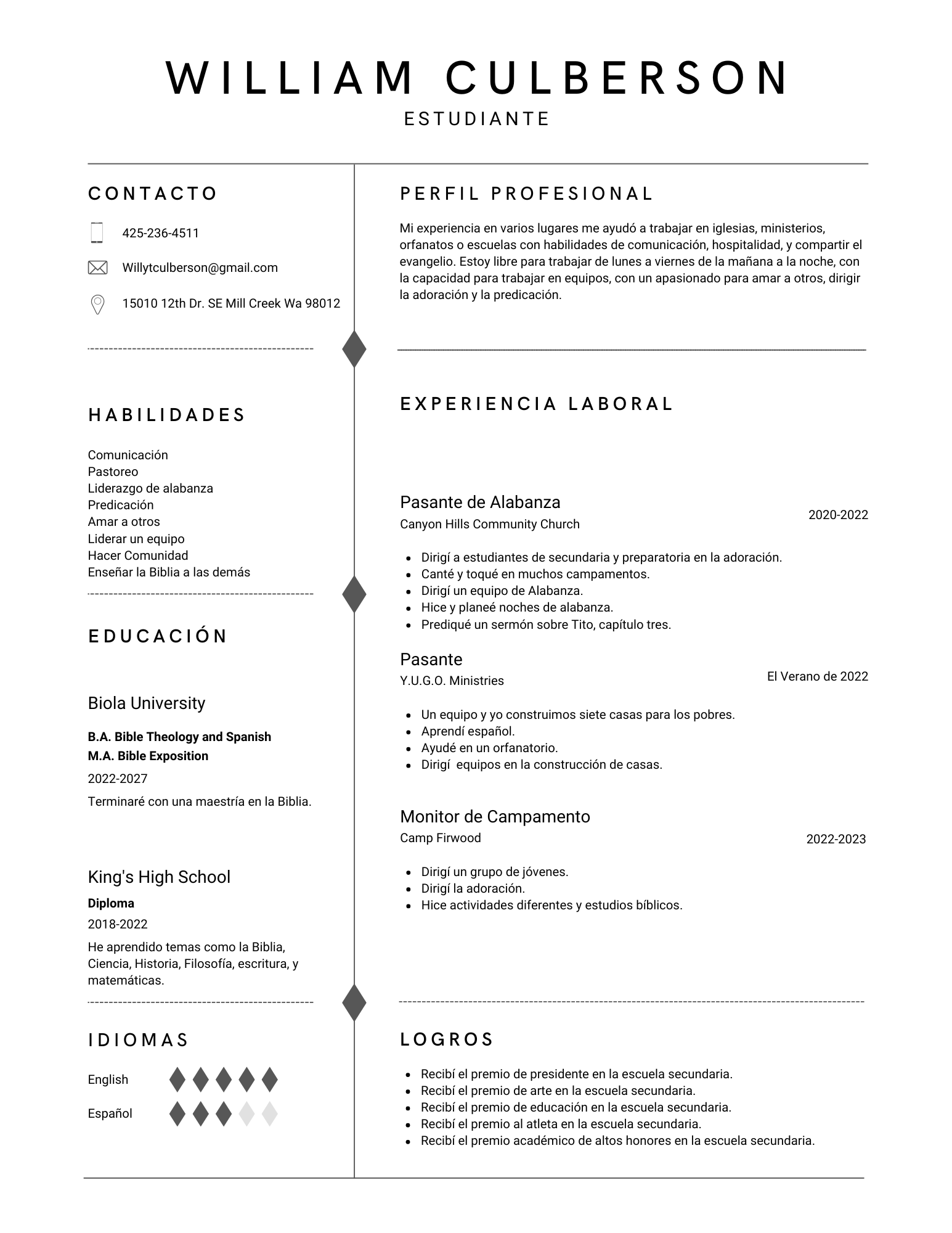
Experiencias Profesionales
Authors Note
This first piece of work is my Resume. Here, you will find my strengths, past experiences, education, internship opportunities, and more. Following this, you will find pieces of my work from my Spanish to English Translation Course that I took during college. The work was accomplished by Luke Franklin (my partner) and myself. This course challenged my linguistic ability in both Spanish and English and allowed me to grow in translating from Spanish to English.
currículum
“Disfrutalo, Todas las experiencias profesionales empiecen en una dia primera.”
Will Culberson
Obras de traducción
Source Text
Cuando Víctor Rey se colocaba en posición de trabajo y ponía una mano sobre el hombro del viejo para hacerlo girar, sintió que otra mano, más dura que la suya, se apoyaba sobre su hombro; viró, sorprendido, y se encontró con la cara de Victoriano. El inspector pudo haber esperado y tomar al cubano con las manos en la masa, es decir, con la cartera del vejete en su poder, pero eso no tenía importancia para él; no le importaban el vejete ni su cartera y apenas si le importaba Víctor.
( Manual Rojas, Chile)
Source Text
El chupinazo
Seis de julio a las doce en punto del mediodía. En Pamplona una mujer enciende el cohete que dará comienzo a las fiestas de San Fermín. Con el ruido del chupinazo nace un grito en miles de gargantas: “¡Viva San Fermín”! La fiesta “estalla”, como escribía Ernesto Hemingway. No hay otro modo de expresar lo que sucede a continuación.
Durante los siete días que duran los sanfermines hay encierros, corridas, rituales y diversiones que no tienen mucho tiempo, aunque la feria en sí tiene más de cinco siglos de antigüedad.
El encierro comenzó siendo una simple maniobra casi obligatoria y no una fiesta. Era la única forma de trasladar los toros desde la dehesa al lugar de la corrida que, en Pamplona, era la Plaza del Castillo.
Los días de corrida, un regidor a caballo guiaba la manada de reses bravas, ayudado por otras personas que iban a pie azuzándolas para que se dieran prisa y no se espantaran. Los vecinos, con palos en la mano, tenían la tarea de vigilar las esquinas de las calles para evitar que los toros se desviaran de su recorrido.
Hace más de un siglo desapareció el regidor a caballo y el pueblo comenzó a tener mayor participación en la tarea. Los jóvenes comenzaron a correr delante de los toros tratando de ser los primeros en llegar a la plaza. Hubo intentos de prohibir el encierro durante el siglo XIX. En 1861 las autoridades advirtieron que la toleraban “aunque la razón pública, la moral y hasta la humanidad reprueban de común acuerdo esa costumbre… ”. Seis años más tarde se realizó el primer encierro similar al actual, prohibiendo la presencia de niños, mujeres y ancianos. Los corredores, que eran muy pocos a comienzos del siglo XX, hoy son excesivos y constituyen un gran peligro. Porque peligro hay, y de sobra, en los encierros.
Quince personas han pagado con su vida el entusiasmo por correr delante de los toros en San Fermín desde el año 1910. Sin embargo, los accidentados son relativamente pocos si se toma en cuenta que miles de personas corren cada ano. Un San Fermín sin encierro ni corridas sería inconcebible.
En Pamplona estalla la fiesta y no hay quien la controle. Se la celebra por calles y plazas, con una dinámica que consigue que vecinos y forasteros madruguen para divertirse. En Pamplona siempre hay sitio para más gente.
Target text
When Victor Rey was placed in a working position and would put a hand over the shoulder of the old man to make him turn, he felt that another hand, stronger than his, was leaning over his shoulder; he turned around, surprised, and he found himself with the face of Victoriano. The inspector could have waited and caught the Cuban red handed, that is to say, with the old man’s wallet in his possession. But this wasn’t of importance for him; the old man didn’t care for his wallet and hardly cared about Victor.
Target text
On the sixth of july, at noon. In Pamplona a woman lights off a firework to begin the festivities of San Fermín. With the noise of the chupinazo, a shout arizes from thousands of throats, “Long live San Fermín!” As Ernesto Hemingway wrote, the festivities “erupt.” There is no other way to express what happens next. During the seven days of the serfermines, there are bullfights, bull runings, rituals, and amusements that don’t take a lot of time, although the festival per say has been going on for more then five centuries of antiquity.
The running of the bulls begins as a simple, almost compulsory maneuver, and not a party. It was the only form of transporting the bulls from the pasture to the place of the bullfight, were in Pamplona, was the Plaza del Castillo.
The days of the running of the bulls, the alderman, on horseback, guided the herd of brave cattle, helped by other people who went on foot urging them to hurry up and not be frightened. The neighbors, with sticks in their hands, had the job of watching the street corners to make sure the bulls ran their course.
More than a century ago the alderman disappeared and the village began to have greater participation in the task. The youth began running in front of the bulls trying to be the first to arrive at the bullpen. There were attempts to ban the bull run during the nineteenth century. In 1861 the authorities warned that they tolerated it “although public reason, morality, and even humanity unanimously condemns this custom’’. Six years later they performed a bull race similar to the first one, prohibiting the presence of kids, women, and elders. The runners, which were few at the start of the twentieth century, today they are excessive and constitute a great danger. Because there is danger and plenty of it, in the bullpen
In San Fermín, since the year 1910, fifteen people have paid with their lives for the enthusiasm of running in front of the bulls. However, the accidents are relatively small when you take into consideration the thousands of people who run each year. A San Fermín without the bullfights or running of the bulls would be inconceivable.
En Pamplona the festivities erupt and there is no one to control it. It is celebrated in the streets and plazas, with a dynamic that gets neighbors and outsiders to get up early to have fun. In Pamplona there is always a place for more people.





